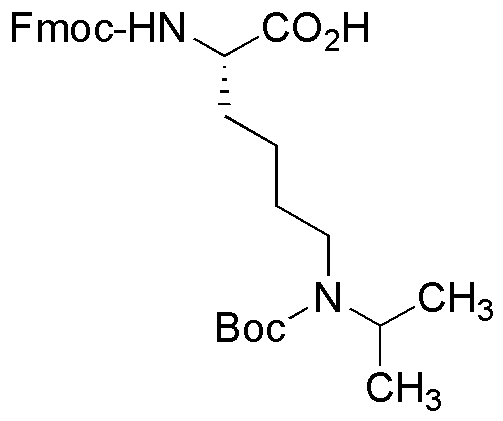Na-Fmoc-Ne-isopropyl-Ne-tert-butyloxycarbonyl-L-lysine is widely utilized in research focused on:
- Peptide Synthesis: This compound serves as a protective group in the synthesis of peptides, allowing chemists to selectively modify amino acids without affecting others. This is crucial for creating complex peptides used in pharmaceuticals.
- Drug Development: Its application in drug formulation helps in enhancing the stability and solubility of peptide-based drugs, making them more effective and easier to administer.
- Bioconjugation: The compound is used for attaching biomolecules to surfaces or other molecules, which is essential in developing targeted therapies and diagnostic tools in the biomedical field.
- Research in Protein Engineering: By facilitating the modification of lysine residues in proteins, it aids researchers in studying protein function and interactions, leading to advancements in biotechnology.
- Cosmetic Formulations: Its properties are leveraged in the cosmetic industry to create anti-aging products, where peptides play a significant role in skin rejuvenation and repair.
General Information
Properties
Safety and Regulations
Applications
Na-Fmoc-Ne-isopropyl-Ne-tert-butyloxycarbonyl-L-lysine is widely utilized in research focused on:
- Peptide Synthesis: This compound serves as a protective group in the synthesis of peptides, allowing chemists to selectively modify amino acids without affecting others. This is crucial for creating complex peptides used in pharmaceuticals.
- Drug Development: Its application in drug formulation helps in enhancing the stability and solubility of peptide-based drugs, making them more effective and easier to administer.
- Bioconjugation: The compound is used for attaching biomolecules to surfaces or other molecules, which is essential in developing targeted therapies and diagnostic tools in the biomedical field.
- Research in Protein Engineering: By facilitating the modification of lysine residues in proteins, it aids researchers in studying protein function and interactions, leading to advancements in biotechnology.
- Cosmetic Formulations: Its properties are leveraged in the cosmetic industry to create anti-aging products, where peptides play a significant role in skin rejuvenation and repair.
Documents
Safety Data Sheets (SDS)
The SDS provides comprehensive safety information on handling, storage, and disposal of the product.
Product Specification (PS)
The PS provides a comprehensive breakdown of the product’s properties, including chemical composition, physical state, purity, and storage requirements. It also details acceptable quality ranges and the product's intended applications.
Certificates of Analysis (COA)
Search for Certificates of Analysis (COA) by entering the products Lot Number. Lot and Batch Numbers can be found on a product’s label following the words ‘Lot’ or ‘Batch’.
Número de catálogo
Número de lote/lote
Certificates Of Origin (COO)
This COO confirms the country where the product was manufactured, and also details the materials and components used in it and whether it is derived from natural, synthetic, or other specific sources. This certificate may be required for customs, trade, and regulatory compliance.
Número de catálogo
Número de lote/lote
Safety Data Sheets (SDS)
The SDS provides comprehensive safety information on handling, storage, and disposal of the product.
DownloadProduct Specification (PS)
The PS provides a comprehensive breakdown of the product’s properties, including chemical composition, physical state, purity, and storage requirements. It also details acceptable quality ranges and the product's intended applications.
DownloadCertificates of Analysis (COA)
Search for Certificates of Analysis (COA) by entering the products Lot Number. Lot and Batch Numbers can be found on a product’s label following the words ‘Lot’ or ‘Batch’.
Número de catálogo
Número de lote/lote
Certificates Of Origin (COO)
This COO confirms the country where the product was manufactured, and also details the materials and components used in it and whether it is derived from natural, synthetic, or other specific sources. This certificate may be required for customs, trade, and regulatory compliance.


